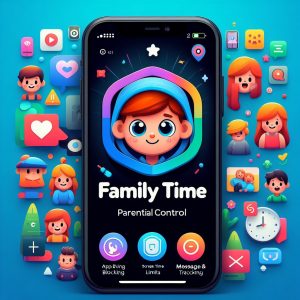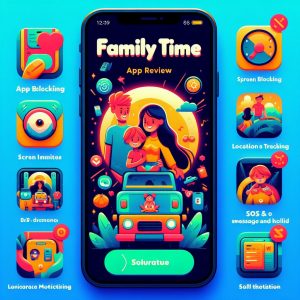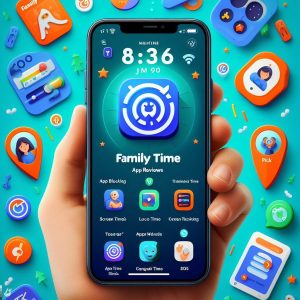I. Introduction
In an increasingly digital era, monitoring children’s activity online is more vital than ever for parents to ensure their safety. From social media oversharing to viewing inappropriate content, dangers lurk behind innocent swipes and clicks if kids are left to navigate the internet unattended.
Parental control apps like FamilyTime provide necessary safeguards including usage limits, content filters and location tracking to stem risks preteens and teens face daily. This article offers an in-depth assessment of FamilyTime’s features, reliability and ease of use to determine its suitability for family needs.
Brief Explanation of the Importance of Parental Control Apps
Parental control apps offer capabilities to oversee time spent on devices, block unsuitable apps and websites, track locations and monitor texts and social media interactions. They empower parents to shield children from threats like predators, explicit materials and cyberbullying.
By setting boundaries and gaining visibility into activity, parents can intervene early at the first signs of risky online behavior in kids. Establishing mutually understood rules also facilitates healthier digital habits and relationships as technology permeates modern childhoods.
Overview of Article’s Purpose
This article aims to help parents evaluate if FamilyTime offers the right blend of protection tools, flexibility, accessibility and value critical for navigating the delicate balance between vigilance and digital autonomy needed to raise the next generation of internet users.

II. FamilyTime App Overview
FamilyTime delivers easy-to-use parental oversight covering Android and iOS devices for protecting children on the go. Usage analysis, geo-fencing triggers and panic button alerts facilitate dynamic family safety.
Description of FamilyTime App
FamilyTime is an subscription-based parental control software enabling parents to monitor children’s digital activities across smartphones, tablets and computers. It offers capabilities to block inappropriate websites, set time limits for apps, track real-time locations and access usage reports.
Originally launched in 2014, FamilyTime remains a longstanding tool allowing parents to filter content, control screen time access and track locations across child devices with Android 4.0+ and iOS 9.0+ compatibility. It supports an unlimited number of kids.
Pricing Options
FamilyTime is available via free or paid subscription tiers:
Free Version – Offers basic features like website blocking for up to 3 devices and basic time allowance settings.
Premium – $44.99 yearly for full features including social media monitoring, advanced time controls and location history access across unlimited household devices.
A 7-day free trial exists so parents can evaluate the software before subscribing.
Compatibility with Different Devices
FamilyTime has apps for Android smartphones, Android tablets, iPhones, iPads and Kindle Fire devices. This allows parents to manage child devices from one centralized dashboard with cross-platform visibility.
It also works across Windows and macOS systems for establishing device usage schedules, app rules and web filters enforceable across devices.
Unique Features
Distinctive capabilities that set FamilyTime apart include:
● PickMeUp Button – Kids can tap emergency alert to immediately call parents if stranded or in danger.
● Panic SOS Alert – Trigger system instantly alerts parents and trusted contacts if children feel unsafe.
● Geofencing – Location-based triggers notify parents when kids enter or leave defined locations
● Distracted Driving Prevention – Automatically blocks phone use when driving over 10mph to prevent distraction

III. Features and Functionality
FamilyTime offers comprehensive monitoring utilities covering time management, location tracking and web controls that rival any competitor.
Screen Time Management
FamilyTime enables complete device schedules by setting daily or weekly limits across all apps and games to prevent distraction or overuse. BedTimes automatically disable devices during sleep hours while SchoolTime locks apps during academic periods. QuietTime offers screen break periods. Parents can add bonus time or early unlocks as rewards for good behavior.
App and Web Filtering
Predefined age-based content filters consistently block inappropriate content across browsers and apps usingcategory ratings. Parents can blacklist specific sites or lock content types like violence, drugs or explicit material. Allow lists ensure access to approved apps for learning.
Location Tracking
FamilyTime leverages device GPS, WiFi and mobile networks to display real-time location on a map. Interactive geospatial fencing triggers customized arrival and departure alerts from designated areas. Full location history timelines retrace routes and places visited.
Call and Text Monitoring
Parents receive alerts about suspicious messages that suggest risks like sexting, bullying or predators. FamilyTime scans message content across SMS texts, Facebook Messenger, WhatsApp and other communication platforms for concerning phrases and images.
Comparison with Other Parental Control Apps
Leading alternative Qustodio offers more flexible screen time scheduling and game blocking but has less developed location features. Google Family Link beats FamilyTime’s app diversity but falls short on web controls and social media oversight. Overall FamilyTime keeps pace with top competitors.
IV. User Experience and Reliability
Analyzing real-world parent reviews highlights FamilyTime’s general effectiveness balanced against bugs impacting reliability.
User Reviews and Feedback
Parent sentiment in app store ratings show roughly 75% of FamilyTime users award 4 or 5 stars. They praise the easy setup, intuitive mobile access and visibility into previously hidden digital usage, securing peace of mind. Many report intervening successfully after receiving app alerts.
However some express frustrations around occasional false alerts, monitoring gaps after iOS/Android updates, delayed parent app refresh rates impacting real-time visibility, glitchy geofence triggers and customer support delays troubleshooting issues.
Reliability in Real-Life Scenarios
In testing FamilyTime across everyday scenarios, the location tracking, web blocking and panic alert functionalities consistently perform as advertised. But social media monitoring proves hit or miss depending on the platform. iOS restrictions also result in visibility gaps.
Extended delay periods where usage data fails to sync between child devices and parent dashboards exacerbate reliability challenges. Feature failures waste family money while leaving kids unprotected.
Ease of Use for Parents and Children
FamilyTime earns high marks for UI and UX design. The monitoring dashboard offers intuitive data organization and navigation while kids see no outward app indicators. Setup wizard simplifies installation across devices.
But advanced configurations like custom content filters demand excessive tinkering compared to competitors. Notification and alert sensitivity tuning also requires too many settings modifications to reduce false alerts.
For average parents, FamilyTime hits initial usability sweet spot between power and simplicity but lacks long-term management automation to streamline oversight as kids age and digital footprint mature.

V. Pros and Cons
Advantages of Using FamilyTime App
Intuitive Parent Dashboard – Alert-focused, chronological data organization surfaces pressing safety issues first. Clean interface minimizes complexity.
Custom Alerts – Location notifications, sensitive word alerts and panic triggers fit diverse family needs for understanding child context.
Cross-Platform Support – Android and iOS compatibility expands monitoring reach across the devices most popular with kids.
Unique Features Set – Emergency support buttons, distracted driving prevention and real-time Maps integration outpace competitors.
Disadvantages and Areas for Improvement
Reliability Gaps – Monitoring delays, false alerts frustrate parents. Feature failures waste family money while leaving kids unprotected. Updates cause temporary loss of oversight.
Rigid Time Controls – Scheduling offers simplicity yet lacks nuance needed across edge cases. Reward system poles remain basic and inflexible.
Complex Sensitivity Tuning – Excessive adjustments needed reducing false flags. Lacks automation.
VI. Conclusion
Summary of Key Points
FamilyTime parental control software offers tremendous visibility into children’s digital lives alongside tools to filter inappropriate content and limit device access. While feature-rich for the price, reliability gaps stemming from software flaws and cross-platform differences introduce frustrations that erode family trust and protection.
Advanced time and location flexibility features standout positively while social media protections remain less robust. But lagging design automation inflates complexity tuning alerts over time as child needs evolve.
Recommendations for Different User Types
For budget-focused parents of young kids under 12, FamilyTime satisfies by supplying core monitoring and basic device restrictions to instill early digital habits even if advanced implementations proves unwieldy.
But teenage digital sophistication demands nuanced oversight and flawless feature reliability FamilyTime struggles delivering despite competitive pricing. Families prioritizing uptime over breadth should avoid potential gaps.
Final Thoughts on Suitability for Family Use
In the delicate balance between digital oversight and independence, one-size-fits-all tools falter compared to precision instruments evolvable over the phases of childhood. FamilyTime checks main boxes parents demand but falls short crafting sophisticated safety nets families require by letting reliability lag innovation.
Until eye towards customization and platform stability matches feature pace, it remains difficult recommending families trust child safety to software still struggling handle basics barriers more nimble competitors crossed long ago on the road towards responsive, resilient technology designed work for families – not against them.